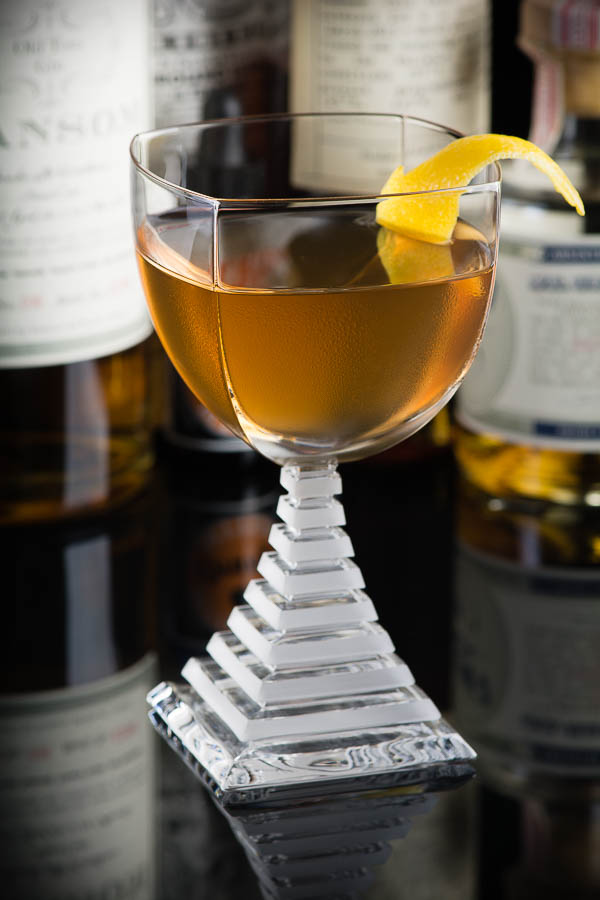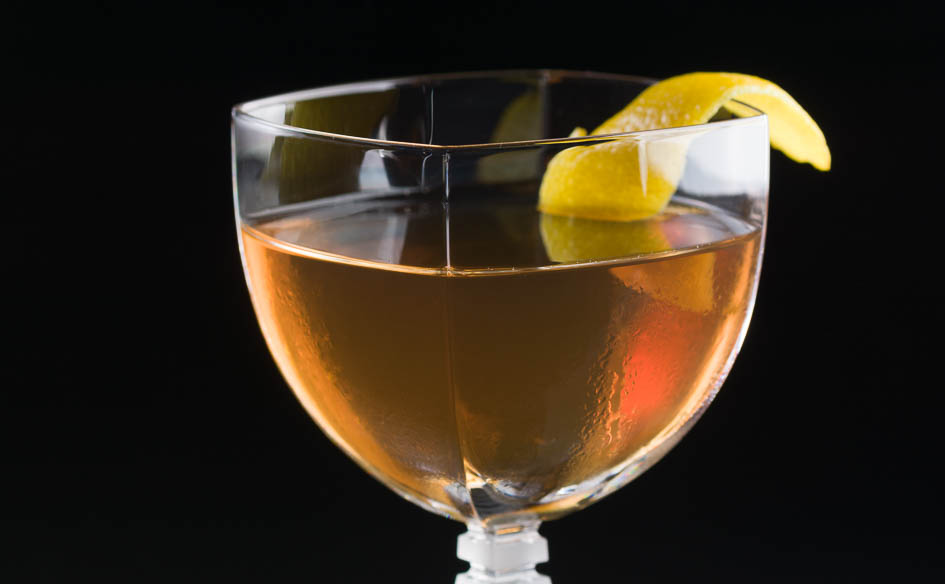The mystery of the Tuxedo Cocktail is trying figure out just which Tuxedo we’re talking about. The Tuxedo is more a spectrum of recipes, rather than a single formula.
One thing we can say is that the Tuxedo is a model of late nineteenth- and early twentieth-century cocktailing. It’s what Jerry Thomas might have called a “fancy martini”—gin, vermouth, bitters, sometimes sherry, often with absinthe, always with a dash of Maraschino.
The earliest reference I’ve found is from Daly’s Bartenders’ Encyclopedia (1903). Tim Daly records a very simple riff on the martini, reminiscent of the Silver Cocktail:
Daly’s Bartenders’ Encyclopedia, 1903
- 2 dashes orange bitters
- 2 dashes Maraschino
- ½ wineglass (1 oz) French vermouth
- ½ wineglass (1 oz) maple gin
Spoon well and strain into a cocktail glass; put in a cherry and twist a piece of lemon peel on top, and serve.
Maple gin?
It turns out that maple gin was a real thing in 1903, but I’m guessing it never really caught on. Daly specifies it a couple times in his Encyclopedia, but I haven’t found references to it in any other cocktail manual.
Which suggests that the bartenders of the day (and their customers) wanted their gin to taste like gin. Daly’s contemporaries wasted no time substituting Old Tom, Plymouth, or London Dry in place of the maple kind.
Jacob Grohusko revised the Tuxedo in his 1910 Jack’s Manual; Grohusko opted for Old Tom gin, and upped the herbal notes in the drink with Angostura and absinthe.
By 1914, some bartenders had switched to London Dry gin, and had taken to adding a barspoon of sherry (Drinks, Jacques Straub, 1914). Over at the Waldorf, the bartenders upped the ante on the sherry—their Tuxedo was simply two parts dry gin to one part sherry, with a dash of orange bitters.
The Tuxedo evolved so quickly, and changed so much, that it seems to be more of an experimental platform than a specific drink.
So where does that leave us? Is there a “right” Tuxedo?
The short answer is, “Sort of.”
Daly’s original is simple and interesting, but that maple gin is problematic. And every time the Tuxedo was published (which was with some regularity) in the years following its introduction, the formula changed.

The ubiquity of the Savoy Cocktail Book, which published two versions of the Tuxedo near the end of Prohibition, provided an anchor of sorts for the formula; what we now typically encounter under the name “Tuxedo” looks very much like one or the other of the Savoy recipes, one of which is basically a Martini with absinthe instead of bitters, and the other a Martini with dashes of orange bitters, absinthe and Maraschino—a recipe nearly identical to one originally published in Harry McElhone’s Barflies and Cocktails in 1927.
So history doesn’t provide a very good guide to a “right” or canonical Tuxedo. The drink has always been a moving target.
That’s the good news—it means that it’s up to you.
Guidelines? Yes, please.
Over time, the only constant attributes of the Tuxedo are that it is usually half gin, typically dry, and half vermouth, also typically dry. Nearly every recipe includes one or two dashes of bitters, either orange or Angostura, or sometimes both. A dash or two of Maraschino is almost always included, and a dash or two of absinthe is common.
And, of course, there is that occasional (and I would say eccentric) fascination with sherry instead of, or in addition to, the vermouth.
So there is your spectrum of flavors; it’s time to make a Tuxedo.
My tastes lean toward McElhone’s formula, which, scaled up to a more modern 3-oz serving, looks something like this:
(Based on Harry McElhone, Barflies and Cocktails, 1927)
- 1 dash (⅛ tsp) Maraschino (Luxardo)
- 1 dash (⅛ tsp) absinthe (St. George Absinthe Vert)
- 2 dashes orange bitters (Bittercube orange)
- 1½ oz Old Tom gin (Ransom Old Tom barrel-aged)
- 1½ oz dry vermouth (Imbue Petal and Thorn barrel-aged vermouth)
Stir with ice until very cold; strain into a chilled cocktail stem. Squeeze lemon peel over the top, and add peel as garnish.
(McElhone’s original formula specifies a garnish of lemon peel and cherry. I think Tuxedo works great with just the lemon.)
 McElhone’s use of Old Tom gin is the only difference between his formula and the one Craddock published as Tuxedo Cocktail (No. 2) in the Savoy, and it’s the reason his version is preferable to the (No. 2). Tom gins have a touch of sweetness that isn’t present in London Dry gins, and I think that probably helps bring the flavors together. Ransom’s aged Old Tom is a perfect base for this drink.
McElhone’s use of Old Tom gin is the only difference between his formula and the one Craddock published as Tuxedo Cocktail (No. 2) in the Savoy, and it’s the reason his version is preferable to the (No. 2). Tom gins have a touch of sweetness that isn’t present in London Dry gins, and I think that probably helps bring the flavors together. Ransom’s aged Old Tom is a perfect base for this drink.
By the same token, Imbue’s Petal and Thorn vermouth seems to help combine the Tuxedo’s flavors; I suspect that’s partly due to the wine’s slight bitter ending on the palate, which may offset of the aggressive sweetness of the Maraschino.
(The barrel-aged Imbue that I used here seems to be a limited edition; I don’t know how widely available it is, nor if it will become part of Imbue’s standard repertoire. I hope it does, but if you can’t find it, try the standard Imbue Petal and Thorn, or the more mainline M&R Dry vermouth.)
It’s important to have a light hand with the Maraschino, absinthe, and bitters. Those ingredients can easily overpower the gin and vermouth and unbalance the drink. The flavors should meld together smoothly, with the Maraschino and absinthe as background notes, not as flavor drivers.
One more thing—the name. The Tuxedo Cocktail isn’t named after the famous dinner jacket, but rather after a ritzy 1880s country club called the Tuxedo Club, America’s “first ‘planned exercise in gracious living,'” according to David Wondrich.
And as you might guess, that’s where the tailless dinner jacket, the result of a youthful rebellion, got its name, too.
“The Tale of the Tuxedo Cocktail” at cold-glass.com : All text and photos © 2015 Douglas M. Ford. All rights reserved.

I actually made one earlier this week—the sherry version, Manzanilla-style—and it was good, but unremarkable; I don’t think I have the sherry gene. I will try your version next time (I’m absolutely giddy about Imbue).
As always thanks for the post; I’m always glad to have your research.
Regards,
Tengrain
I know what you mean about the sherry gene—I don’t seem to have it, either. Wish I did, but… no. (I keep trying, though.)
I hope you enjoy the Imbue version of the Tuxedo—I like it a lot. And if you can find the Ransom Old Tom, so much the better!
Thanks for taking time to join in, have a great day.
I have always preferred the old tom version of the Tuxedo, although I typically omit the absinthe. The absinthe is good in the cocktail but seems “cleaner” without the absinthe, have also tired Peychaud’s to replace the absinthe which is also good but also took out the nice clean flavor that you get from the rest of the drink.
There seem to be many ways to make the Tuxedo, and your “no absinthe” variant seems plenty legit to me. “Clean” is an intriguing attribute, and provides an interesting angle for evaluating a cocktail. Thanks for the suggestion.
Thanks for adding Tuxedo to the library! I’ve made the McElhone version with the exception of coating the glass with the St. George absinthe vs. stirring in… not sure if it makes a difference but I do really like this cocktail.
I’ve tried it both ways, and coating the glass, Sazerac style, works just fine. The main difference seems to be whether the absinthe is present more in the nose or on the palate. (I tend to go with absinthe washes—I love a nose full of absinthe—but the good part is that everyone gets to pick his favorite.)
Greate recipe – the PDT cocktail book has anice compromize solution – similar, but with Plymouth gin and a lot heavyer (1/4 oz) on the Maraschino. I prefter using Old Tom though Ransom is a bit rough – Jensens old tom works just right.
I’m not familiar with the Jensen gin, it would be interesting to try one day, if it shows up in my market. Thanks for the suggestion.
>
Hi Doug, D. Wondrich is one of my references but the IBA recipe is the same as yours, what’s your opinion about this Tuxedo?
Many thanks!